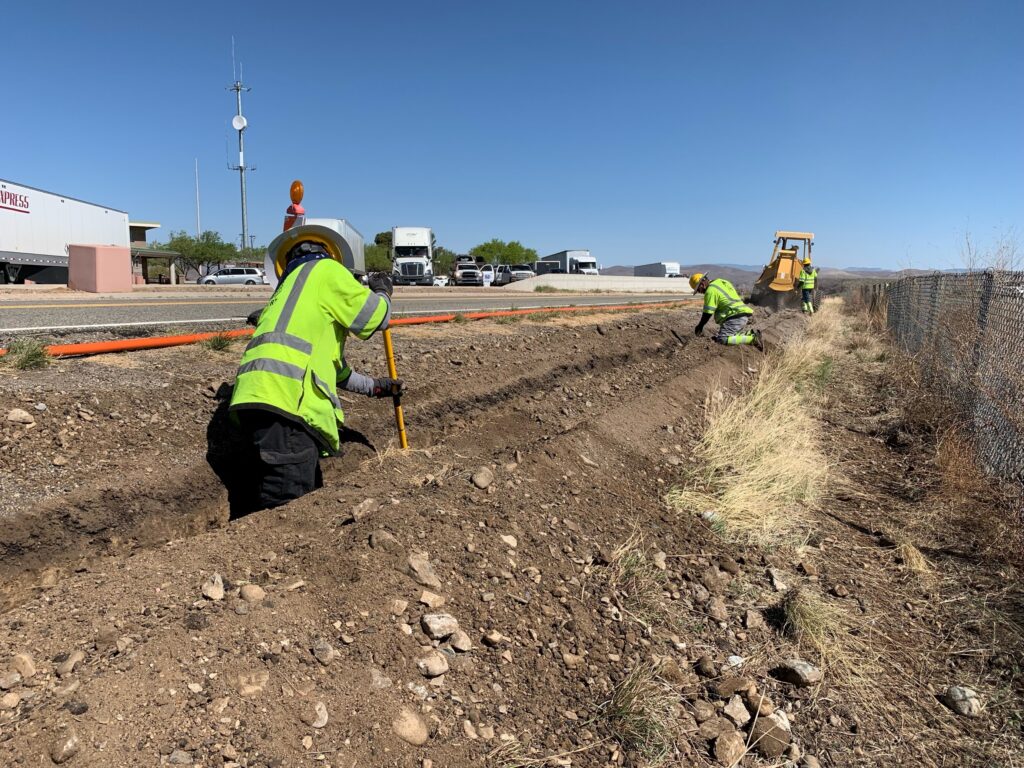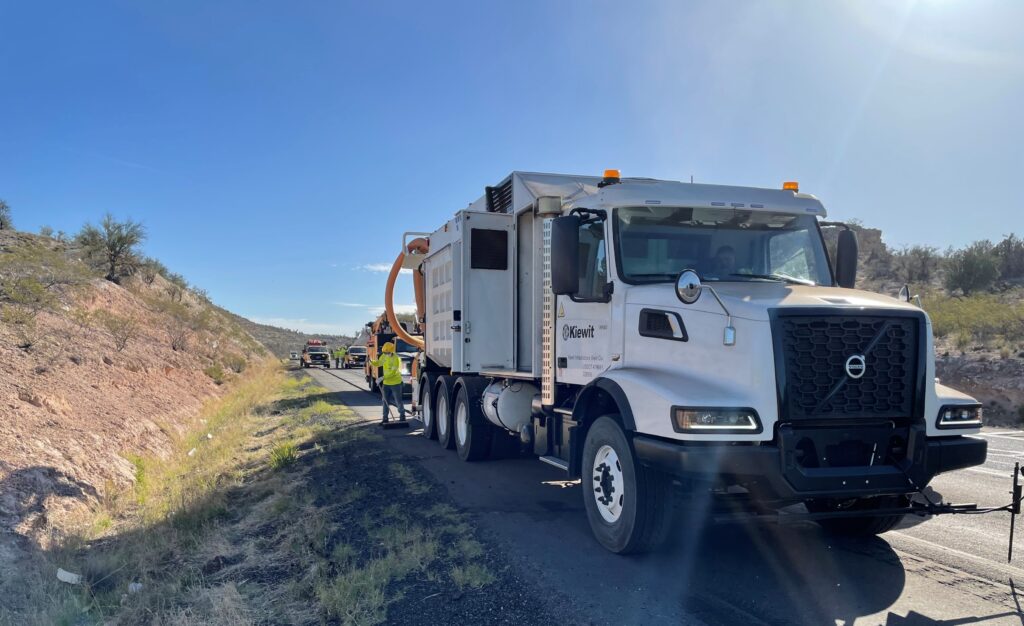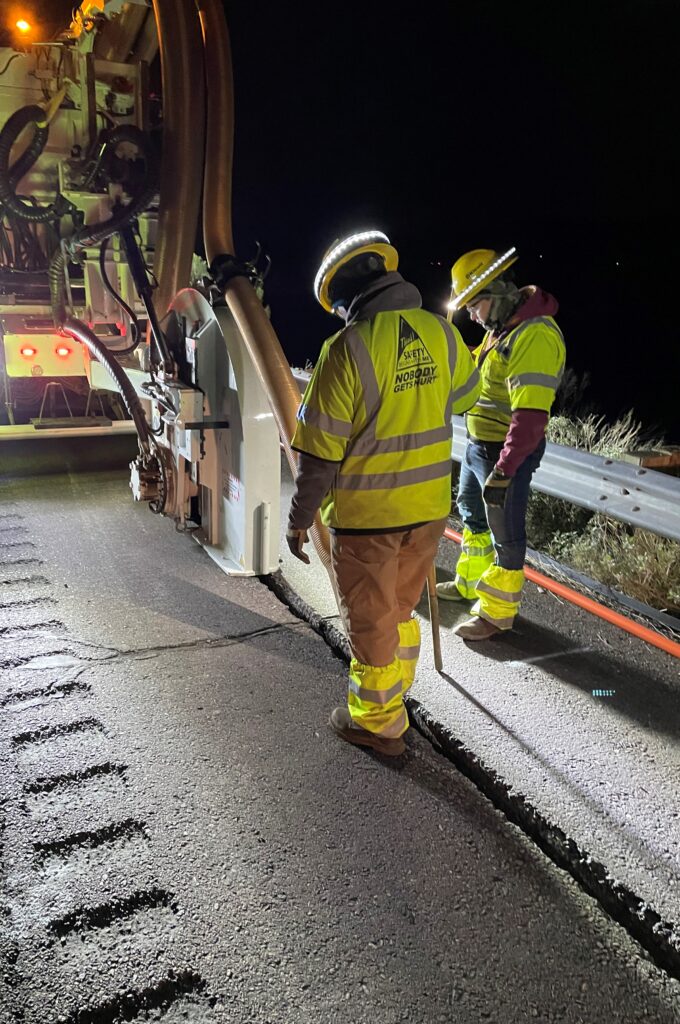Faced with a challenging Arizona landscape, the I-17 ITS Infrastructure project team created an innovative workaround — one that’s also paved the way for future contracts.
On Interstate 17 from Phoenix to Flagstaff, Arizona, there’s plenty of rough terrain and congested traffic. Motorists on the route must keep an eye on the busy road as they encounter narrow lanes and a mountainous landscape with an elevation change of about 1,300 feet.
In 2021, Kiewit was tapped to be the Construction Manager at Risk (CMAR) for a 67-mile project for the Arizona Department of Transportation (ADOT). The job: Install high-speed/capacity fiber optic backbone infrastructure that will be used for interconnecting Intelligent Transportation Systems (ITS) field devices and providing infrastructure for rural broadband.
The technology allows ADOT to monitor traffic flow via connectivity to cameras, closed-circuit televisions, digital message signs, ramp meters and flow detectors — with a constant eye on addressing traffic congestion and collisions. It also brings high-speed internet to previously underserved and unserved communities.
As the CMAR, Kiewit would not only be responsible for the construction, but would also bring its expertise, in partnership with the owner’s designer, to provide a constructible, fast and cost-effective solution.
Getting creative
Looking at the initial design plans and providing preliminary cost estimates, the team quickly discovered that trenching through the rocky, mountainous terrain to install the infrastructure posed a particular set of hurdles.
“We recognized early on that the job was initially designed for the conduit to be installed off the shoulder of I-17 for a majority of the project length,” said Project Manager Brian Hamilton.
“Our team identified a significant amount of risk with performing off-shoulder trenching on this specific stretch of I-17. There’s a lot of rock in the area and that presents issues anytime you’re trying to trench, because you not only have to create access to work, but also saw through the rock. You’re going to spend more time preparing the areas and installing the conduit, so your overall cost is going to
be higher.”
To be able to build what ADOT envisioned and do it on budget, the team had to get creative. What if they moved the trench from off the shoulder to in the shoulder?
Less costly, more efficient
The team was familiar with an installation method called microtrenching. This concept had been developed in Europe and was relatively new to North America; it was just being introduced in the United States.
The method held promise. It could be done with a narrow and relatively shallow trench. Working in the interstate shoulder would mitigate the risk of encountering rock and other obstructions like roadway signage, lighting and drainage.
Even better, it was less costly.
“We had zero experience with microtrenching,” said Area Manager Nick Wiatrowski. “The majority of our research for this installation was done on projects in Europe.”
The team put their heads together to gather as much information as possible, knowing this wouldn’t be business as usual.
“Generally speaking, transportation departments avoid routing utilities underneath the roadway. The preference is to route them on the side of the roadway, and out of the way,” said Hamilton.
Kiewit partnered with the designer and ADOT to work through a new concept of installing a trench into the shoulder — very narrow in width and at a shallow depth.
The team also planned to install a multi-microduct conduit in the trench with capacity for up to seven different fiber optic cables. This microduct worked well with the microtrenching solution, not only providing an avenue for ADOT’s fiber optic network but also for future communication companies to use the space for broadband.
“It was a win-win, being brought on board early on, to where we could shape the design and provide good constructability feedback to ultimately come up with the best design at the lowest project cost,” said Hamilton. “The department listened and was open to our feedback.”
A strategic move
Working with Tesmec, the trenching equipment manufacturer, the team created an innovative way to cut a trench just 3-1/4 inches wide and 14 inches deep. The team worked with Tesmec’s sales and engineering groups to determine the optimal saw dimensions for the project and established an onsite training program to train Kiewit’s operators.
Equipped with dust mitigation capabilities and onboard spoil handling containment technology, the Tesmec CleanFast truck sucks up the dust and material as the equipment saws through the asphalt pavement and aggregate base course, creating a clean solution.
Believing in the effectiveness of the system and betting the investment would pay off for future roadway jobs, Kiewit made the decision to purchase two CleanFast trucks.
It was a strategic move for the organization, knowing there was a program in place in Arizona for similar work, and support for fiber and broadband expansion at the federal level.
“We’ve seen with the Infrastructure Investment and Jobs Act that broadband was a big initiative across the United States,” said Wiatrowski. “Our ability to purchase the equipment that we need and learn new technology to construct the work helps us to diversify our company.”
Setting the bar higher
“Contractually, we couldn’t place our first traffic control device until 7 p.m. and were required to have all traffic control devices off the road by 6 the following morning,” said Hamilton.
That created a tight work window for the team. But every day, beginning in Jan. 2022, team members challenged themselves to set the bar a little higher, ultimately bringing the job in ahead of schedule.
“This method of long, linear microtrenching was new to the company and there was no previous roadmap established for how to efficiently complete this type of work,” said Hamilton. “Our crews celebrated when they achieved new production goals, but the team was never satisfied and always motivated to install more.”
“The repetitive nature of this work allowed the team to brainstorm and challenge each other to figure out a faster way of putting the conduit in the ground. The overall concept was simple, but we were able to make adjustments along the way to improve production and quality throughout the entire project.”
Kara Lavertue, resident engineer for the ADOT Northwest District, praised the team’s ability to respond to questions in the field and resolve issues quickly. She noted that Kiewit’s work will continue to pay dividends.
“The work done on this project will benefit the state immensely,” said Lavertue. “The project helped bring fiber-optic broadband to northern Arizona and will serve the citizens in remote areas.”






